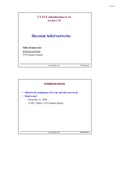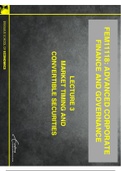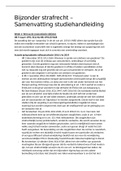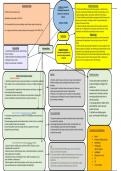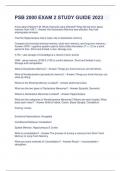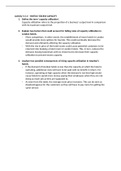2021/2022
,Learning unit 1: Understanding demand and the service
you provide
1.1 Introduction
In this learning unit, you will be introduced to the concept of market demand and shown the importance
this plays in understanding the transport sector, the types of services that the sector provides, and how
to manage these services. You will be provided with a complete overview of market demand in the
transport sector, and be shown how the demand profiles of transport operations are traditionally
defined. From here you will learn about the differences in demand profile between freight and
passenger transport services and the various factors that affect demand in these sub-sectors. Finally, you
will be provided with a comprehensive understanding of the post-apartheid trends in the structure of
the South African transport market, focusing specifically on the evolving state of transport infrastructure
in the economy and the extent to which this has influenced, and been influenced by, transport demand.
1.2 List of resources
1.2.1 Prescribed readings
Madre, J. (2003). Passenger Traffic. In European Conference of Ministers of Transport (pp. 26–36).
Paulley, N., Balcombe, R., Mackett, R., Titheridge, H., Preston, J., Wardman, M., Shires, J., White, P.
(2006). The demand for public transport: The effects of fares, quality of service, income and car
ownership. Transport Policy, 13(4), 295–306.
Pedersen, P. O. (2001). Freight transport under globalisation and its impact on Africa. Journal of
Transport Geography, 9(2), 85–99.
Perkins, P., Fedderke, J., & Luiz, J. (2005). An Analysis of Economic Infrastructure Investment in South
Africa. South African Journal of Economics, 73, 211-238.
Vickerman, R. (2003). Freight Traffic. In European Conference of Ministers of Transport (pp. 15–25).
1.3 Activities
1.3.1 Prescribed reading
Read the following prescribed reading:
,Paulley, N., Balcombe, R., Mackett, R., Titheridge, H., Preston, J., Wardman, M., Shires, J., White, P.
(2006). The demand for public transport: The effects of fares, quality of service, income and car
ownership. Transport Policy, 13(4), 295–306.
This paper provides an overview of the core factors that influence demand for public transport. It
presents the key findings from a collaborative study whose objective it was to produce an up-to-date,
synthesised guidance manual on the dynamics of the demand for public transport. Whilst a wide range
of factors was examined in the study, the paper concentrates on the findings regarding the influence of
fares, quality of service and income and car ownership on transport demand. Although the context is
principally that of urban transport in Great Britain, extensive use was made in the study of international
sources and examples, so the findings are universally applicable. As this manual was generated for use by
public transport operators and planning authorities, as well as for academics and other researchers, it
will be a very useful guide not only to your study of this module, but also to your future work in the
transport management field.
Reflection
The previous reading makes use of elasticities to examine and quantify
demand in the transport market. Revisit this reading when you shif
your focus to the calculation of demand elasticities in Learning Unit 3,
in order to understand the methodology that went into generating
this manual.
1.3.2 Prescribed reading
Read the following prescribed reading:
Pedersen, P. O. (2001). Freight transport under globalisation and its impact on Africa. Journal of
Transport Geography, 9(2), 85–99.
This reading provides an excellent history of the changes in the freight transport market that have
occurred during the contemporary period of globalisation, with a specific focus on the influence these
changes have had on the nature and demand structure of the transport market in Africa and on
development on the continent. It traces the history of freight transport and development in Africa, and
shows how freight transport demand with the changes to logistic chains that have occurred as a result of
globalisation. It then delves deeper into the changes in inter-continental and intra-continental freight
transport that have occurred in Africa as a result of globalisation, and traces the effects both of these
new transport models have had on the demand for freight transport across the continent.
myUnisa Discussion Forum 1.1
The previous reading shows that the period of globalisation has seen
most freight transport hubs in Africa increase their number of inter-
, continental flight connections, but decrease their number of intra-
continental flight connections. Reflecting on what you know about
globalisation and neo-liberalism, why do you think this trend has
occurred and what does this mean for trade in Africa? Post your
discussion in the appropriate Discussion Forum on the myUnisa page.
1.3.3 Prescribed reading
Read the following prescribed reading:
Madre, J. (2003). Passenger Traffic. In European Conference of Ministers of Transport (pp. 26–36).
This reading provides a comprehensive overview of the factors that influence passenger traffic demand
and the tools that are available to manage this demand. Using a case study from France, it covers the
traditional economic drivers of transport demand, most notably transport supply, and also touches on
the structural, demographic and geographic factors that have a key influence on passenger traffic
demand. From here, it examines the traditional responsibility of transport ministries with regards to
managing transport demand, and the synergies between transport departments that are necessary for
the successful management of this demand.
Reflection
The previous reading examines the various factors that generally
influence passenger transport demand, and uses the case study of
France to examine the tools available to transport ministries in the
management of this demand. Using your knowledge of the South
African transport market, and government’s influence in the market,
what tools can you think of that the South African government has
implemented to manage transport demand?
1.3.4 Prescribed reading
Read the following prescribed reading:
Vickerman, R. (2003). Freight Traffic. In European Conference of Ministers of Transport (pp. 15–25).
This reading provides an excellent overview of freight travel demand as well as a critical review of the
methods used in freight travel demand modelling. It begins by introducing the components that are
necessary for the modelling of freight transport demand, and then critically examines the simple derived
demand model which has traditionally been used to model and forecast freight demand. It finds that
these traditional models are inadequate in accurately modelling freight transport demand, and presents
new approaches for the modelling of freight transport – using the EU region as a case study. This is a

